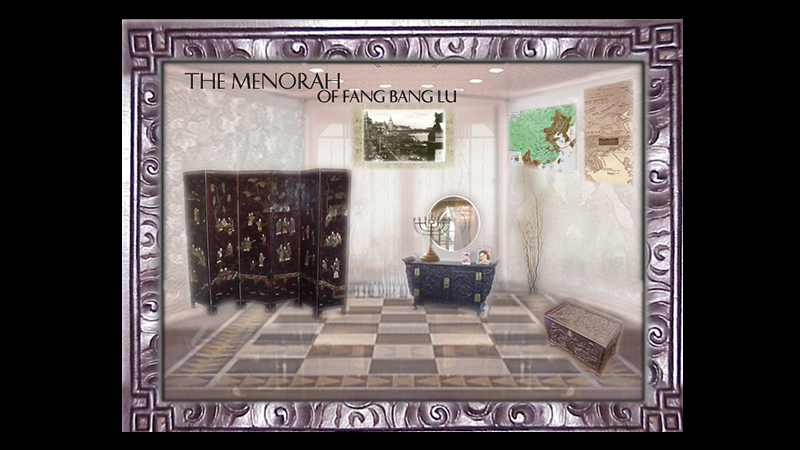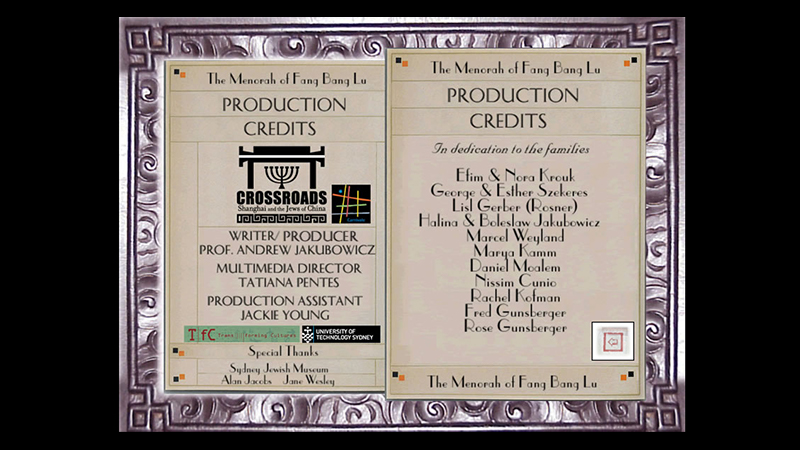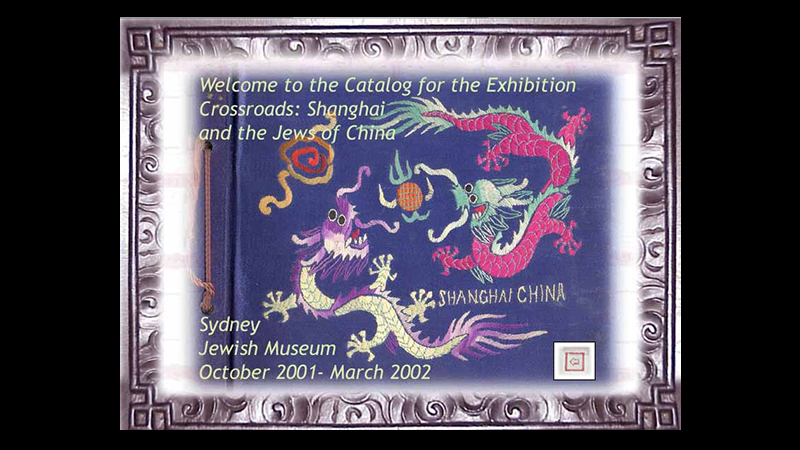Editor's Introduction
"What can a single artifact tell us about history? For an archaeologist schooled in deciphering subtle traces, a lone relic can speak volumes. So it is with the 19th century brass menorah at the center of Andrew Jakubowicz's The Menorah of Fang Bang Lu. Serving as a metaphor for the intertwining stories of four Jewish families living in Shanghai in the late 19th and early 20th centuries, this object also provides evidence of a community that has since disappeared from the city, having joined the worldwide Jewish diaspora during World War II, only to make their way to Australia. Their stories are told and this history is pieced together through interviews with surviving family members and collections of photographs, documents and testimonies that describe a strikingly similar set of experiences. Jakubowicz's exhaustively documented site offers a model for constructing a multi-perspectival portrait of a moment from the past that cannot be otherwise reconstituted. The family stories that constellate around the image of the menorah describe a set of common themes emerging from individual experiences with immigration, community and participation in an economic system. At the same time, the stories remain separate and distinct, a subtle evocation of the fact that none of the families knew each other when living in Shanghai; it is only through this reconstruction after the fact that their lives have been woven into a larger historical narrative. As a piece of historical evidence whose origins can only be conjectured, the menorah also functions as a metaphor for Jakubowicz's investigation. The graceful folk tune that emanates from the music box in the base of the menorah is at once familiar and indecipherable, some of the notes having been long since worn away, but leaving enough of the tune intact to provide a suggestive starting point for historical enquiry. Like the films of Hungarian Peter Forgacs, who constructs historical narratives out of home movies shot by WWII era European Jewish families, Jakubowicz's work resonates with traditions of oral history and history-from-below, implicitly arguing that the stories of 'ordinary' people should not be excluded from the historical record." – Tara McPherson and Steve Anderson, Vectors Editors
Author's Statement
"Shanghai
has an iconic quality in the West - a place out of time and space where
cultures explode and opportunities expose themselves. Its physical
presence - Victorian waterfront and post-modern skyline - reflect
trajectories of empires long lost, and futures spinning relentlessly in
many directions. Since its eruption as a Western nodule on the marshy
plains along the bend of Whampoo river in the 1850s, Shanghai has evoked
that heady mixture of sin and profit that entices new generations to
its now ever-more canyon-like streets.
My parents were Polish
Jewish refugees from Nazism who found respite there during WW2, by then
in Japanese-occupied China. It was a curious period, a time of moderate
safety and great anxiety, a space within which threatened lives could be
held together by the tenuous community and impoverished networks of
other refugees. By 1941 when my parents reached the city from Kobe in
Japan there were over 30,000 Jews in the city - about 10% of the
non-Chinese population, and 1% of the total population. These people had
come from Poland, Russia, Manchuria, the former Ottoman empire, India,
Turkey, the Nazi occupied countries of Europe (especially Austria and
Germany and Czechoslovakia) and a variety of other sources - indeed the
whole Jewish diaspora was reflected in the city. I was aware of this
story throughout my childhood, and became a fascinated observer of its
surfacing into public knowledge as China emerged from the totalitarian
isolation of Maoism.
Throughout the 1990s I had been interested
in the potential of this story to appeal to wide audiences, and to throw
light on the serendipitous moments that allowed it to form - although
there was academic literature and some popular writing already in print.
The 1990s saw the production of a number of documentary films about
Shanghai, unearthing archival footage, and generating hundreds of hours
of interviews. As well the Visual History Foundation of the Shoah had
instigated its 50,000 or more survivor testimony project, and in that
group were people who had transitted Shanghai. Meanwhile survivor
organisations were establishing websites to provide points of
connection, and advance wider global knowledge about the Jews of
Shanghai.
As a sociologist interested in new media and
communication, I had also been involved for some time in the development
of educational multimedia. One project, Making Multicultural Australia,
had taken six years to reach CD-rom stage (released as a 3 disc set in
1999), and a further five years to be transformed for the Web. That
project, a partnership between my research group (Trans/forming Cultures Research Centre). So when the Sydney Jewish Museum
decided in 1999 to develop and mount an exhibition on Shanghai and the
Jews of China, I became involved in two roles - as a research adviser on
the historical detail, and a planner of the thematic structure of the
display; and as the producer of an accompanying online component. With
Tatiana Pentes as the designer (an award winning multimedia creator), we
set out to create a website built around the stories of Jewish families
whose paths crossed in Shanghai in the 1940s, and who lived in Sydney
at the dawn of the 21st century.
In October 2000 I travelled
with my partner Mara Moustafine to research the sites of Shanghai and
document the city photographically. Mara, born in Harbin in Manchuria,
knew the city well and had many contacts there. She had undertaken an
earlier visit and had set in train work by local researchers to identify
key buildings and locations. One of my goals was to locate each of the
places in which my family had lived. Mara's colleague at the Shanghai
Academy of Social Sciences, the historian of Russian Shanghai Professor
Wang Zhicheng (known as Alexander or Sasha to his friends), had located
nearly everything. However the building in Hongkou (historic Hong Kew)
in which the family had spent the 'ghetto' years of 1943 to 1946 had not
been found.
One Sunday morning Mara and I went to the old
Chinese city - now a tourist area with Yu Yuan gardens at its heart. The
street leading to the gardens and the famous crooked bridge and
teahouse nearby is known as Fang Bang Lu. Near the western end of the
street stands an antique and old goods market. As we wandered through
the stalls we spotted a brass Star of David in a heap of old brassware. I
pulled it free and discovered it was part of a seven-branched
candelabra known as a Menorah, and in its base a wind-up music box had
been fitted. I bought the piece, and knew then that it would serve as
the motif for the website on Shanghai. It was to become the Menorah of
Fang Bang Lu. Later that day we found the Dairen Lu rowhouse in Hongkou
where my parents had lived - it was about to be demolished. Two weeks
later it was gone - and when I went to look for the site in 2002 the
street had disappeared under the Hongkou-Pudong metroline.
The
music box remained an enigma. No one could recognise the tune. In 2003 I
had a jeweller friend Ralph Shaw undo the box - and we found that the
box, manufactured in Switzerland, had half the tines missing from the
comb. No wonder then that it was only playing the upper register of the
tune. Ralph could not find a replacement. In October 2004 while at MIT
in the USA, I met Tod Machover, a researcher into musical machines at
the Media Lab, and mentioned my dilemma. He had just returned the
previous weekend from driving in Maine, where in the small town of
Wiscasset, Maine he had stopped at 'The Musical Wonder House', and
encountered its owner, an elderly Ukrainian by the name of Mr
Konvalinka. He had known a lot about music boxes. I hit Google and found
the place and its owner. I emailed him and then telephoned him. I
described my problem and he said he would see what he could do. I then
phoned Mara's mother, Inna Moustafine, in Australia, who retrieved the
box from Ralph, and express posted it to Maine. A few days later
Konvalinka phoned and said he could try to fix the box. A week later he
phoned again and down the line came the sound of the completed musical
comb - playing the old Hebrew Chanukah song 'M'ao Tzur'. Mara recognised
it immediately. That dilemma was resolved.
But how did a
Menorah with a Hebrew melody end up in a Chinese junk shop half a
century after the Jewish community left Shanghai? That mystery
remains...
So where next? The Menorah project suggests a
new way of doing research and publishing it. In conjunction with the MIT
Metamedia group, we are developing the possibility of a multimedia
interactive research archive (labelled 'M.I.R.E'). In conjunction with
museums, libraries, archives, and individual scholars we are creating a
selection of multimedia objects - interviews, digitised images,
panoramas, video clips, audio files, music, digitised posters,
government documents, police files, personal records. Each object is
metatagged, carefully coded, and linked to other objects to which it is
related. Each object can also have commentaries, arguments and other
texts attached (each also metatagged). A tracking device will show how
users have used the archive, displaying both heavy pathways and areas of
low interest. Finally a publication program will be developed to
mobilise the archival elements in online projects.
The heartland of the archive as a 'proof of concept' will be some 150 items from the Menorah of Fang Bang Lu - including the two music-box tunes that serve as bookends to the story." -- Andrew Jakubowicz, from Vectors, Volume 1, Issue 1, Fall 2005
Designer's Statement
"Tatiana
Pentes is a digital media artist. Recently she has produced interactive
media works that explore the meeting of documentary and narrative forms
in an electronic context. The projects she has worked on include
* blackBOX online/CD-ROM,
* Strange Cities CD-ROM,
* The Menorah of Fang Bang Lu online documentary, and recently,
* Scenes from a Shanghai Hotel digital DVD film, produced in association with the Australian Film Commission.
These
projects focus on Shanghai as a cultural milieu in film and literature.
Interest in working on these projects has evolved from exploring the
émigré experience of her Russian grandparents in Shanghai, China. The
legacy of her grandfather Serge Ermoll Snr, jazz musical scores and
photographs, memorabilia from his orchestra which once played in the
dance halls and cabarets of Shanghai, have inspired a journey back to
Shanghai as 'melting pot', an idealised space, and place of refuge/
exile for Russians and Europeans following the second world war.
She is completing a doctor of creative arts in Humanities and Social Sciences (UTS)." -- from Vectors, Volume 1, Issue 1, Fall 2005
Project Credits
"Researcher
Mara Moustafine
Production Assistant
Jackie Young
Curatorial production
Jane Wesley
Exhibition director
Alan Jacobs
Opening song
Nissim Cunio, Kim Cunio
Subjects
Efim Krouk, Nora Krouk, Fred Gunsberger, Rose Gunsberger, Marcel Weyland, Halina Jakubowicz, Rachel Kofman, George Szekeres, Esther Szekeres, Daniel Moalem, Lisl Rosner" -- from Vectors, Volume 1, Issue 1, Fall 2005
1 COPY IN THE NEXT
Published in Fall, 2005 by Vectors in Volume 1, Issue 1.
This copy was given to the Electronic Literature Lab by Erik Loyer in November of 2021.
PUBLICATION TYPE
Online Journal
COPY MEDIA FORMAT
Web


